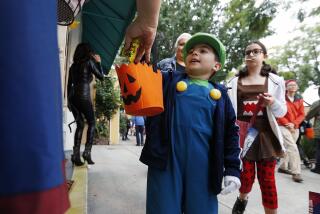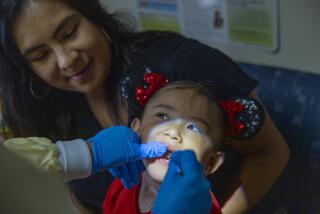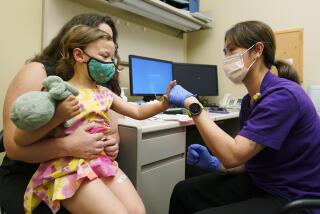PARENTING : Filling a Need : Families seeking a specialist to deal with their children’s teeth and fears turn to a pediatric dentist.
- Share via
When Candee Messmore took her son Spenser to the dentist when he was 2, the examination nev er moved beyond Spenser’s clenched mouth.
“The dentist’s attitude was that my son needed to be big and sit in the chair alone, without me there,” said Messmore, who lives in Granada Hills. “The whole experience started so negatively that he remembered it and referred to it for a whole year.”
Messmore’s story, say experts, is not uncommon, and its impact can be far-reaching. Childhood fears can turn into a lifelong dread of dentistry, which, in turn, may keep even adults from seeking the care and treatment they need.
To head off this kind of trauma for her son, Messmore made an appointment with a specialist trained to handle children: a pediatric dentist. During his first visit, she said, “Spenser forgot all his fears. When we walked in, there was a treasure chest full of toys. The dentist let Spenser push buttons, move the chair up and down, squirt the water and touch all of his tools. He even demonstrated the tools on Spenser’s arm.”
Such playfulness and sensitivity are no accident, according to Dr. Stephen Howard, a Tarzana dentist also known as “Dr. Supertooth.”
“During the first year of pediatric dental training,” he explained, “we receive classes that revolve around the emotional and psychological growth of the child. Kids go through so many changes, and a good dentist has to be aware of what level they’re on. You don’t want to talk down to them or use language they don’t understand.”
To find a pediatric dentist who is both qualified and simpatico, Howard suggests getting a referral from a satisfied parent. “Then just show up at the office and ask to look around,” he advised. “If the staff is receptive to the visit, that’s a good sign.”
Many preschools offer group visits to dental offices, where kids get hands-on experiences with dental tools, said Howard, who has hosted such visits himself during his 20 years in practice.
*
To calm youngsters before their first appointment, Pat Azarnoff, executive director of Tarzana-based Pediatric Projects, advises parents to express confidence in the dentist but not to offer unnecessary details. “Just prepare them for what they will see and feel,” said Azarnoff, whose organization distributes toys and books to help children understand health care. “Say, ‘We need to keep your teeth clean and healthy and the way we do that is that a dentist checks your teeth. You will need to sit in a chair, open your mouth wide, like this, so the dentist can see inside. And I’ll be right beside you.’ ”
Howard added that parents can take cues from dentists about how to simplify complicated dental language for young children. “We talk about putting a Band-Aid on a tooth, not drilling a filling,” he said. “And we don’t give shots, we put a tooth to sleep.”
Similarly, Howard rejects the term “waiting room” in favor of “family room.” In his office, this is a place packed with toys and computer games for children of every age. Pictures of patients are on a bulletin board, some taken with a giant bear Howard keeps on hand.
Dr. Mostafa Rad, who has practiced pediatric dentistry in Woodland Hills for six years, allays children’s fears by giving them choices. “I ask them what flavor of fluoride they want--strawberry, banana, bubble gum or mint,” he explained. “It gives them a sense of control and boosts their confidence level. I become like a friend.”
Another welcoming device involves the layout of a dentist’s office. Instead of closed examination rooms, Howard’s floor plan features a large open bay that harbors five dental chairs. “One child can see that the other kids are OK while they’re being examined, and it creates peer support,” Howard said. “It eliminates that closed-door feeling.”
Should an examination take place in a separate room, most pediatric dentists allow parents to accompany their children. “A child sees the exam as this new experience and they need mom or dad near to help translate it,” said Azarnoff. “There is no substitute for a trusted parent at a young age.”
*
When a child turns 5, say experts, parents can usually begin cutting down the time they spend in the examination room.
Moms and dads who take their children to a pediatric dentist might be shocked to learn that it can cost more than their own dental care--an average of $60 for a visit. But, like Messmore, many parents who have tried the alternatives have no complaints, especially when they encounter someone like Howard.
“For the better part of 17 years, I came to work each day dressed as Dr. Supertooth, wearing white tights, blue trunks and a red cape with a tooth logo on my chest,” Howard recalled.
While many of his patients have outgrown the gimmick, and he has put it aside, he is still known to some by his larger-than-life moniker.
“This business,” he said fondly, “is all about how to make dental visits light and easy. We do it for the kids.”
Putting Teeth First
Introducing children to the dentist early can lay the foundation for a lifelong habit of good dental hygiene.
According to Pat Azarnoff, executive director of Tarzana-based Pediatric Projects, “There are many children today under the age of 10 who have never had a cavity because they’ve been getting checkups and fluoride from the start.
“The American Dental Assn. recommends taking children in by age 1,” she said, “then once or twice a year after that for checkups to see if the teeth and jaw are growing properly.”
An early visit benefits grown-ups as much as it does their children, said Dr. Mostafa Rad, a dentist who practices in Woodland Hills. “It teaches parents to care for their baby’s teeth and gums.”
During the consultation, dentists can also evaluate--and inform parents about--any adverse habits, such as thumb-sucking, and they can determine a child’s fluoride needs. X-rays may be taken to determine if the teeth and facial bones are developing properly and to spot any hidden decay.
As soon as a child’s first teeth begin to appear, usually by the 13th month, Rad suggests draping a gauze pad or washcloth over a finger to wipe the teeth gently. After the child is used to the procedure, parents can use a soft-bristled toothbrush with a small dab of toothpaste. They should also floss when the child’s teeth become close enough to trap food particles, as well as brush after breakfast and before bedtime.
Kids can begin helping out with brushing at age 4 or 5, a practice Rad encourages to build confidence. Depending on their manual dexterity, many children will be cleaning their teeth on their own before they’re 8.
Experts advise parents to set a good example by brushing and flossing their own teeth twice each day, and by visiting their dentists regularly.
For children with particular fears or questions about dentistry, the following books, geared for youngsters ages 2 to 6, may prove helpful to parents:
* “My Dentist,” by Harlow Rockewell, Morrow Books, $4.95.
* “Going to the Dentist,” by Anne Civardi and Stephen Cartwright, EDC/Usborne Books, $3.95.
* “The Berenstain Bears Visit the Dentist,” by Stan and Jan Berenstain, Random House, $2.50.
* “Just Going to the Dentist,” by Mercer Mayer, Western Books, $2.95.
More to Read
Sign up for Essential California
The most important California stories and recommendations in your inbox every morning.
You may occasionally receive promotional content from the Los Angeles Times.










